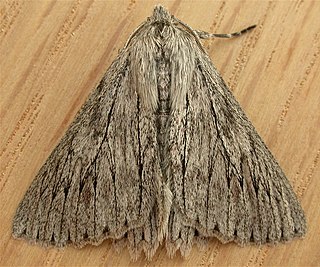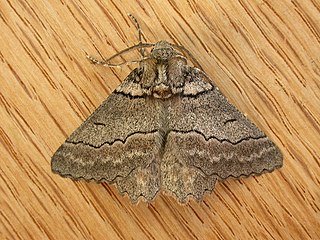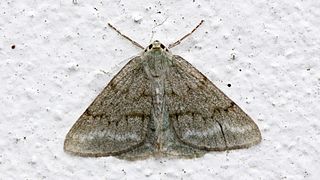
Cyneoterpna wilsoni, or Wilson's grey, is a moth of the family Geometridae first described by Rudolf Felder and Alois Friedrich Rogenhofer in 1875. It is found in the Australian states of Queensland, New South Wales, Victoria, South Australia and Tasmania.

Rhuma argyraspis is a moth of the family Geometridae first described by Oswald Bertram Lower in 1893. It is found in Australia, including Queensland.

Hypobapta is a genus of moths in the family Geometridae described by Prout in 1912.

Hypodoxa is a genus of moths in the family Geometridae described by Prout in 1912.

Metallochlora is a genus of moths in the family Geometridae described by Warren in 1896.
Paraterpna is a monotypic moth genus in the family Geometridae. It consists of only one species, Paraterpna harrisoni, which is found in New South Wales, Australia. Both the genus and species were first described by Gilbert M. Goldfinch in 1929

Pingasa is a genus of moths in the family Geometridae first described by Moore in 1887.

Hypobapta percomptaria, the southern grey, is a moth of the family Geometridae first described by Achille Guenée in 1857. It is known from Australia, including South Australia, New South Wales, Queensland, Victoria and Tasmania.

The Pseudoterpnini are a tribe of geometer moths in the subfamily Geometrinae. The tribe was described by Warren in 1893. It was alternatively treated as subtribe Pseudoterpniti by Jeremy Daniel Holloway in 1996.
Epipristis oxyodonta is a moth of the family Geometridae first described by Louis Beethoven Prout in 1934. It is found in Western Australia, the Northern Territory and Queensland in Australia.
Hypobapta barnardi, or Barnard's grey, is a moth of the family Geometridae first described by Gilbert Macarthur Goldfinch in 1929. It is found in the Australian states of Queensland, New South Wales, South Australia and Western Australia.

Hypobapta xenomorpha is a moth of the family Geometridae first described by Oswald Bertram Lower in 1915. It is found in Australia.

Hypobapta tachyhalotaria is a moth of the family Geometridae. It is found in Tasmania and possibly New South Wales and Queensland.
Hypodoxa conspurcata is a moth of the family Geometridae first described by Thomas Pennington Lucas in 1898. It is found in Australia, including Queensland.

Hypodoxa emiliaria is a moth of the family Geometridae first described by Achille Guenée in 1858. It is found in Australia, New Guinea and on the Solomon Islands.
Hypodoxa erebusata is a moth of the family Geometridae first described by Francis Walker in 1860. It is found in Australia, including Queensland.
Pingasa cinerea, the tan-spotted grey, is a moth of the family Geometridae. The species was first described by William Warren in 1894. It is found in the Australian states of New South Wales, Queensland, Tasmania and Victoria.
Pingasa nobilis is a moth of the family Geometridae first described by Louis Beethoven Prout in 1913. It is found in New Guinea and Queensland, Australia.
Aeolochroma turneri is a moth of the family Geometridae first described by Thomas Pennington Lucas in 1890. It is found in Australia's Northern Territory and Queensland.
Aeolochroma viridicata is a moth of the family Geometridae first described by Thomas Pennington Lucas in 1890. It is found in Australian states of New South Wales and Queensland. Adultsts have a complex green and brown or grey pattern.










